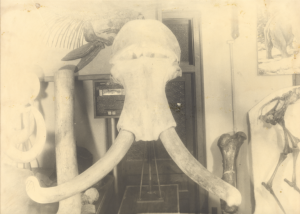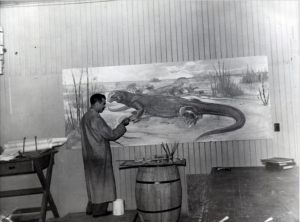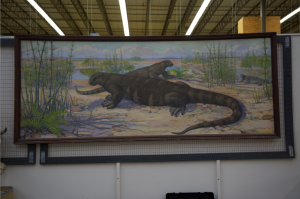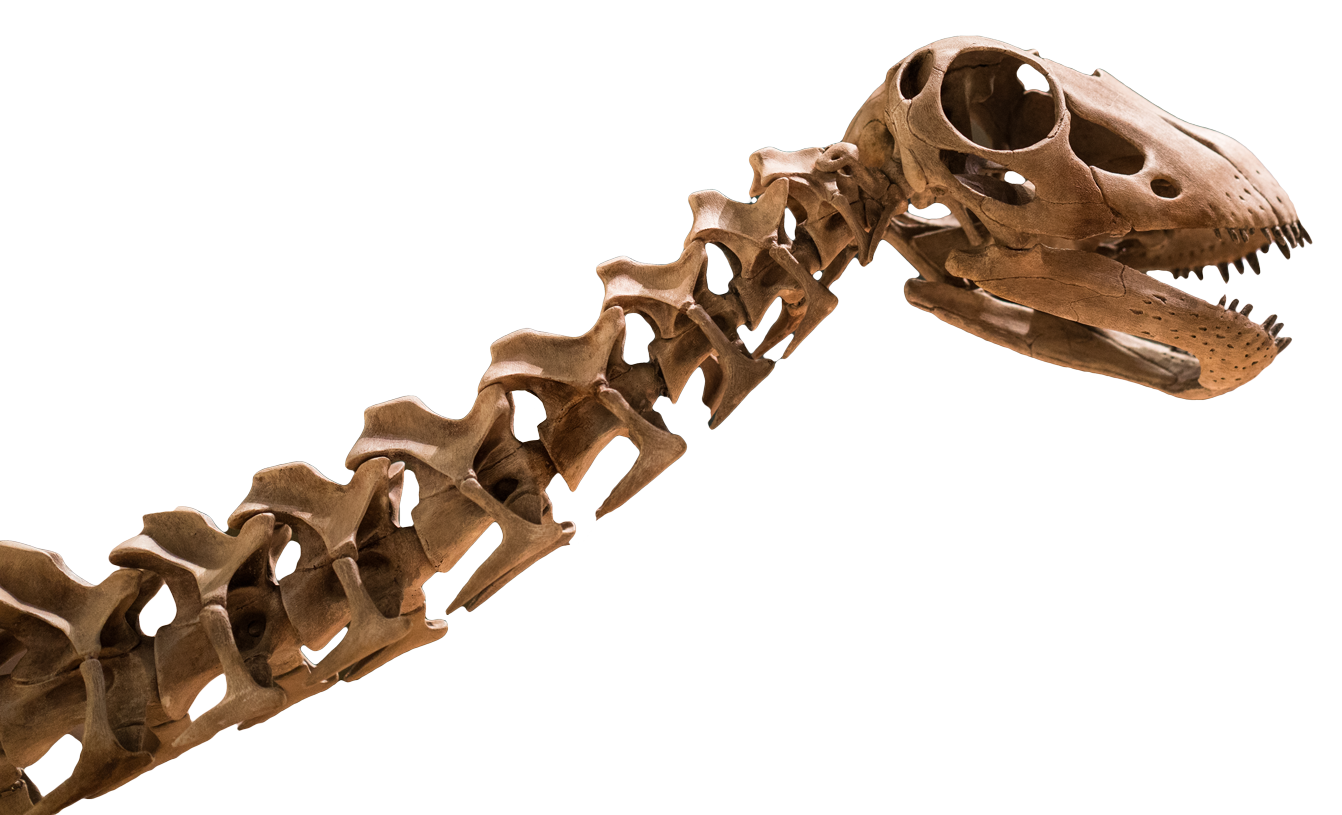It started with a mammoth butt.

While working as a graduate student at the Sam Noble Museum in 2015, James Burnes stumbled upon a huge discovery. Almost as huge as the mammoth’s behind that started it all.
Burnes, currently the exhibits coordinator at the OU Libraries, digitized and organized images for the vertebrate paleontology collection. It was during this time that he noticed several large-scale paintings had seemingly disappeared since the late 1930s and early 1940s.
While scanning a negative of a mammoth skull, he noticed a portion of a painting in the top right-hand corner, just visible from behind the specimen. A mammoth butt was all that graced that corner, but it was enough to spark Burnes’ curiosity.
And so began Burnes’ journey to track down these mysterious paintings. He learned that they were created by artist Ralph Shead, assistant director of the Sam Noble Museum, who became acting director after its first director, J. Willis Stovall, passed away in 1953. Shead was in charge of art and murals at the museum and oversaw the museum’s Works Progress Administration projects during the 1930s.
On May 28, 2017, Burnes published a post on his blog, Paleo Porch, detailing his search for these paintings. Someone commented on the post, stating that they knew where the paintings were.
“When OU Landscape Management moved its headquarters into the old Stovall museum buildings, there were four large paintings standing in the corner stacked against each other,” said Burnes. “To me, the paintings were missing, but to Conrad Zindel, a 17-year-old temp worker in 1997 who liked the paintings enough to hang them in the break room, they are just something that he has seen every day for the last 20 years!”
Zindel’s wife, Brandy, and her sister Kimberly Cloud were the ones that commented on Burnes’ blog post.
“I dropped everything and directed her to contact me, and we started figuring out how to orchestrate the rehoming of these nearly 85-year-old paintings,” said Burnes. “It culminated with me meeting Conrad at his shop.”
Due to upcoming building renovations, the paintings were removed from the wall and were not scheduled to be re-installed.
“They were coming to install sheetrock in the area where the paintings were being temporarily stored, so we had to act quickly,” said Burnes. “Through the course of the day, the two largest paintings were taken down to the Sam Noble Museum, and the two smaller ones, including the mammoth one that started this whole adventure, were taken to Conrad’s and Betty’s house until they could be re-homed.”
The paintings ended up at the OU Landscape Management facility after the Sam Noble Museum sent the paintings to OU property surplus in the late 1990s.
“As new scientific information was discovered, it became apparent that the subjects represented in the paintings, previously used as exhibit backdrops in the 1930s, were no longer scientifically accurate,” said Tracy Bidwell, Sam Noble Museum registrar. “For many years, museum staff tried to determine what should be done with the paintings.”
Prior to moving into the new museum, Vertebrate Paleontology Curator Rich Cifelli selected the most scientifically accurate paintings to adorn the paleontology research corridor in the new facility on Chautauqua Avenue. Julie Droke, former museum registrar, tried to contact family members of Shead to release the remaining paintings, but did not have any luck. After careful consideration, the museum decided to send the remaining paintings to OU property surplus, where they eventually found various new homes.

After opening the Pandora’s Box of paintings, Burnes began the hunt for Shead’s painting of the Cotylorhynchus, a creature from the Permian. The painting had been sent to surplus due to its scientific inaccuracy.
“As far as I know, that painting is the first time that specimen had ever been visually reconstructed, which is important for the history of science since it’s the first documented environment that was created for the Cotylorhynchus,” said Burnes. “Even though we’ve moved further and know more about the species and the Permian period, it still has historical significance, even if it’s no longer significant in paleontological reconstruction.”
Burnes began to track down the painting. After a few dead ends, Burnes contacted Tom Luczycki, head of exhibits at the Sam Noble Museum, and told him of his plight.
“I reached out to both past and present members of the department that were there when the paintings were removed from the old museum,” said Luczycki. “They could only confirm reports of an OU student hauling a 10-foot canvas towards the dormitories.”

Luczycki then turned the investigation over to Cifelli and Kyle Davies, fossil preparator for the vertebrate paleontology department. They searched their archived emails and revealed that the Cotylorhynchus painting was on display at the Texas A&M Biodiversity Heritage prep lab, after previously residing in a college student’s apartment.
“The former student presented it to the Biodiversity Research and Teaching Lab after he graduated,” said Burnes. “People there thought it was a painting of a Komodo Dragon, and it quickly became a staff favorite.”
Burnes knew he had to find a way to bring the painting home, since the Cotylorhynchus is an important piece of Norman history
“The Cotylorhynchus was discovered just north of Norman,” said Burnes. “It’s Norman’s native son.”
Luczycki was hoping to retrieve the painting during the 30th anniversary of the Sam Noble Museum’s designation as the state’s official natural history museum.
“I reached out to both Catherine Hastedt, director of the TAMU art galleries, and Heather Prestridge, curator of biodiversity research and teaching collections,” said Luczycki. “I made an impassioned plea for the return of the work, or at very least, a loan.”
To his great pleasure, they offered to give the painting back to its original home.
After delays due to Hurricane Harvey, Burnes and Luczycki finally headed south in September 2017 to retrieve the painting. Upon seeing the painting, Burnes realized that he had actually seen it years before.
“While attending Lamar University as an undergraduate, and long before I had an interest in Shead and his work, I had visited the TAMU prep lab,” said Burnes. “I had now come full-circle on a journey I didn’t even realize I was taking.”
Seven hundred miles later, Norman’s native son had returned. The Cotylorhynchus painting has been back at the Sam Noble Museum for just over three years now. The painting is not the only rendition of the creature the museum has – a Cotylorhynchus fossil lives in one of the museum’s permanent galleries, the Hall of Ancient Life. This year, its painting and skeleton are joined by a more “life-like” version in the museum’s newest temporary exhibit, Permian Monsters: Life Before Dinosaurs. The exhibit features an animatronic Cotylorhynchus, along with other Permian creatures, to educate visitors on a time period not widely known.


